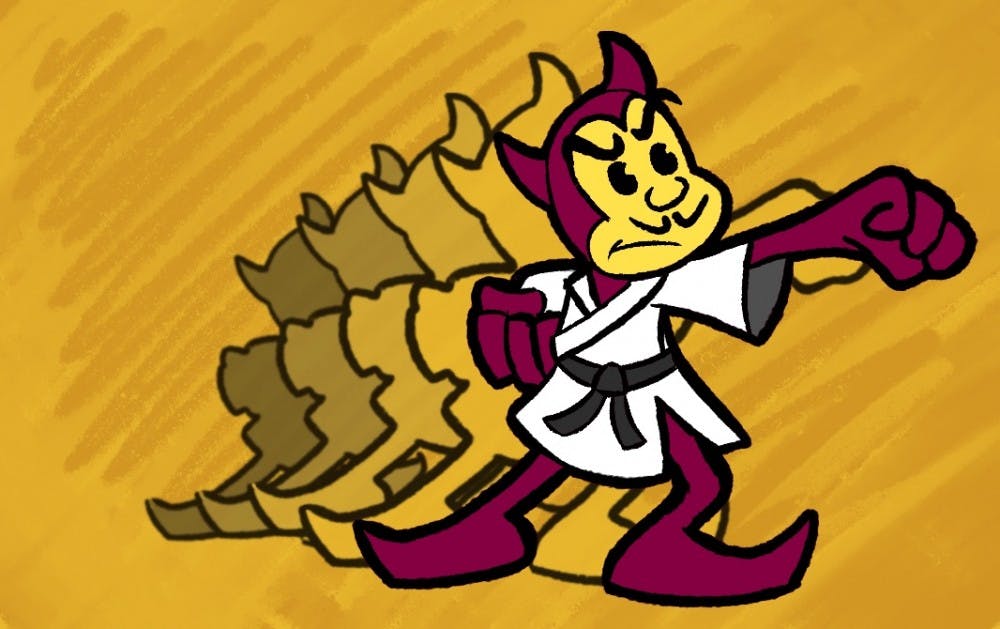The Tempe Sun Devil Fitness Center allows a personalized approach to fitness with the various classes offered. Among them, the martial arts programs are some of the most beneficial and underappreciated.
Martial arts provide several benefits, so they can appeal to anyone. Whether students want the confidence to defend themselves, the mental and physical benefits of exercise, or to simply try something different, a martial arts class can be an effective alternative to traditional workouts.
Classes range in category, increasing the likelihood students can find one that works for them. There are grappling arts such as Ju-Jitsu, striking arts such as Karate or Krav Maga Self Defense, which incorporates aspects of grappling and striking from various martial arts.
“There’s a very good set of martial arts classes here, and a lot of them are running with only five or 10 people in them each semester,” said Fionn Sheerin, a volunteer Japanese Ju-Jitsu instructor at the SDFC.
The SDFC programs have the advantage of being much cheaper than those offered off-campus. Students pay a one-time fee of $36 to $75 depending on the course, then have access to classes for the full semester. This is significantly cheaper than other gyms in Tempe, as almost all traditional gyms require a monthly payment and some sort of contract.
However, SDFC classes can only be joined at the start of the semester before the posted deadlines.
With over 50,000 students on the Tempe campus alone, more people should learn about and consider joining one of these classes when they open again next semester. Each offers at least one free week, so there’s no financial risk in trying.
In terms of physical fitness, Ju-Jitsu increases strength and flexibility through submissions, throws and positional holds. Emphasizing technique over size, this art practices effective self-defense methods while also improving health.
Krav Maga involves punches, kicks, elbows and other movements for a great cardio and strength workout. It was developed for the Israel Defense Forces and involves aggressive techniques to fend off attackers.
The more gentle arts such as Chen Taijiquan and Aikido have been found to improve balance and aerobic conditioning. They also have mental health benefits, with the effect of relieving anxiety and stress. Other classes to consider include Kung Fu, Qi Gong and more.
Martial arts classes are relatively safe, but instructors encourage students to start early to get better with training and conditioning.
“My only concern as an instructor is the safety of the class,” Sheerin said. “If I get a student halfway through the semester, they’re at risk of injury because they’ve missed all the conditioning and practice set up early on.”
For students who are interested in taking up a martial arts class right now, it is worth it to contact the SDFC to see if a safe accommodation can be made.
If that fails and students are willing to pay more money, there are several gyms located off campus with classes in Brazilian Jiu-Jitsu, kickboxing, MMA and more. Students who take this route should ask whether a gym requires a contract, has student pricing and if it is safe for beginners.
For those who are willing to wait, SDFC martial arts classes will open again in the Fall 2018 semester. Interested gym-goers should step out of their regular routines of cycling or lifting weights to try out at least one martial art. In doing so, students may find a practical, healthy, and affordable new hobby.
Reach the columnist at jkbeneve@asu.edu or follow @JacobBenevento on Twitter.
Editor’s note: The opinions presented in this column are the author’s and do not imply any endorsement from The State Press or its editors.
Want to join the conversation? Send an email to opiniondesk.statepress@gmail.com. Keep letters under 500 words and be sure to include your university affiliation. Anonymity will not be granted.
Like The State Press on Facebook and follow @statepress on Twitter.




